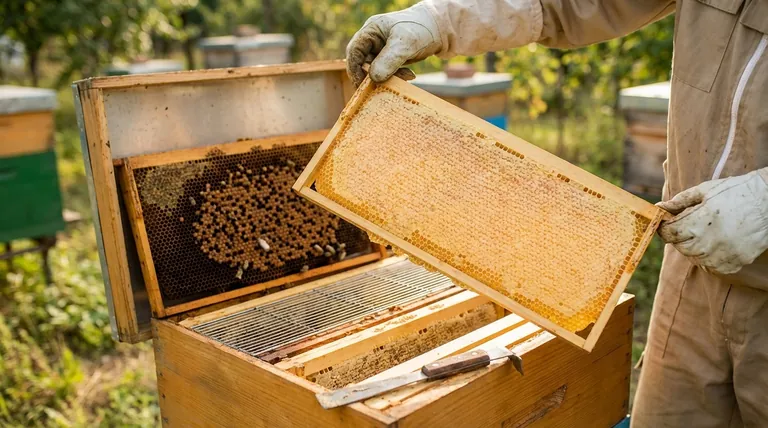It is a fundamental rule in beekeeping that you should not harvest honey from frames that contain brood. Doing so jeopardizes the next generation of bees and compromises the quality of your honey. The correct practice is to harvest exclusively from frames in the "honey supers," which are separate boxes designated for surplus honey storage.
The separation of the brood chamber (the hive's nursery) from the honey supers (the hive's pantry) is the single most important principle for ensuring both a healthy colony and a pure, high-quality honey harvest.

The Hive's Layout: Brood vs. Honey
To understand why this separation is critical, you must first understand the hive's natural organization. A beehive is not a random collection of honeycomb; it is a highly structured home and factory.
The Brood Chamber: The Heart of the Colony
The brood chamber, typically the bottom box or boxes of the hive, is the nursery. This is where the queen lays her eggs and where the young bees—in their egg, larval, and pupal stages—are raised.
These frames contain not only brood but also stores of pollen (often called "bee bread") and some honey, which serve as the immediate food source for the developing bees and the nurse bees who tend to them.
Honey Supers: The Pantry for Surplus
Honey supers are the boxes placed on top of the brood chamber. Their sole purpose is for the bees to store surplus honey—the honey that is not needed for the colony's immediate survival.
Beekeepers often place a queen excluder, a screen with specific-sized gaps, between the brood box and the supers. This allows worker bees to pass through but is too small for the larger queen, ensuring she cannot lay eggs in the honey supers.
Why Harvesting from Brood Frames is a Mistake
Attempting to extract honey from a frame containing brood is detrimental for several critical reasons, impacting both the bees and the final product.
Jeopardizing the Next Generation
The most immediate consequence is the destruction of the developing bees. The process of uncapping and spinning frames in a honey extractor will inevitably kill the vulnerable eggs, larvae, and pupae, severely setting back the colony's growth and future workforce.
Contaminating the Honey
Brood frames are a mixture of brood, pollen, propolis, and honey. Extracting from these frames introduces biological materials and debris into your honey. This "brood juice" contaminates the honey, affecting its flavor, clarity, and shelf stability.
Weakening the Colony
The honey and pollen stored around the brood are not surplus; they are the strategic food reserves for raising the young. Removing this vital food source puts immense stress on the colony, forcing them to consume resources that would otherwise support their growth and health.
The Hallmark of Harvest-Ready Honey
Knowing what to avoid is half the battle. The other half is knowing what to look for in frames that are ready for harvest.
The Importance of Capped Honey
Bees cap a cell of honey with a fresh layer of beeswax only when they have reduced its water content to below 18%. This process cures the nectar into honey and prevents it from fermenting.
The 80% Rule
A frame is considered ready for harvest when at least 80% of its cells are capped. A fully capped frame is even better. Harvesting honey with too much uncapped nectar results in a high water content, which will lead to fermentation and spoilage.
A Simple Checklist for a Healthy Harvest
Use these principles to guide your harvesting decisions and ensure a practice that is both productive for you and sustainable for your bees.
- If your primary focus is colony health: Always leave the brood box entirely for the bees and only harvest surplus honey from dedicated honey supers.
- If your primary focus is honey quality: Only extract from frames that are at least 80% capped with clean wax to guarantee low moisture content and prevent fermentation.
- If you are managing your hive for efficiency: Use a queen excluder to maintain a clear and simple separation between the brood nest and your honey stores from the start.
Respecting the hive's natural structure is the key to a sustainable and rewarding harvest.
Summary Table:
| ✅ Do Harvest From | ❌ Do NOT Harvest From |
|---|---|
| Frames in honey supers | Frames in the brood chamber |
| Frames with at least 80% capped honey | Frames containing eggs, larvae, or pupae |
| Clean, wax-capped cells | Cells mixed with pollen and propolis |
Ready to optimize your beekeeping operation?
As a leading wholesale supplier to commercial apiaries and distributors, HONESTBEE provides the durable equipment—like precise queen excluders and efficient honey supers—you need to maintain this critical separation and maximize your harvest yield and honey quality.
Contact our expert team today to discuss your wholesale needs and ensure a healthy, productive season.
Visual Guide

Related Products
- HONESTBEE 3-Frame Manual Acrylic Honey Extractor
- 6 Frame Manual Stainless Steel Honey Extractor Beekeeping Equipment
- Plastic Hand Crank 2 Frame Honey Extractor Low Price
- Stainless Steel 3 Frame Manual Honey Extractor Spinner for Bee Honey Extraction
- 2 Frame Stainless Steel Manual Honey Spinner Extractor for Beekeeping
People Also Ask
- What equipment is used for honey harvest? Essential Tools for Every Beekeeper
- What is the most common method for cleaning a honey extractor? Protect Your Honey & Equipment
- How do you collect honey at home? A Beginner's Guide to Harvesting from Your Hive
- How do you manually extract honey? Choose the Best Method for Your Hive
- What is a fun and easy alternative to using a honey extractor for harvesting honey? Try the Crush and Strain Method



















